Where Did Pabst Win that Blue Ribbon?

A vintage Pabst Blue Ribbon advertisement from the mid 1950s.
“Go get me a blue ribbon.” I must’ve heard my grandpa utter those words hundreds of times as we sat together fishing off our small dock. Even before I could read I knew which beer to grab for him – the one with the first prize ribbon on the can. I didn’t realize it as a child of course, but that ease of recognition was a testament to the power of branding.
Pabst Blue Ribbon beer –PBR to its friends– may today be best known as the preferred beer of old Midwestern fisherman and mustachioed hipsters, but that instantly recognizable ribbon is more than just a symbol or marketing ploy. Pabst did, in fact, win a first place award at one of the most celebrated events in American history. The year was 1893 (a time when everyone looked like a mustachioed hipster) and in Chicago, Illinois, America’s greatest architects and planners had created a fairground unlike any the world had ever seen, a utopian White City.
1893 Columbia Exposition

The White City of the 1893 Columbian Exposition in Chicago.
The World’s Columbian Exposition, also known as the Chicago World’s Fair, was convened to celebrate the 400th anniversary of Christopher Columbus’s arrival in America. It was a key moment for design and invention in America. Products such as Juicy Fruit, Crackerjack and Shredded Wheat were introduced to the public for the first time. The Ferris Wheel made its grand debut, outshining the Eiffel Tower and proving that there was no limit to American engineering and imagination. Westinghouse electrified the fairgrounds with alternating current electricity, setting the standard for a nation. Nikola Tesla stunned visitors by shooting lighting from his hands, Thomas Edison thrilled them with the Kinetoscope’s moving pictures, and former steamship captain Frederick Pabst got them drunk on the best damn beer they’d ever tasted.
Pabst’s Best Select –PBS to its friends, presumably– won the top beer award at the 1893 Exposition. Previously, the beer had won many other awards at many other fairs – so many, in fact, that Captain Pabst had already started tying silk ribbons around every bottle. It was a time when beer bottles were more likely to be embossed than labeled and the ribbons were likely added at great cost to Pabst. But Pabst’s display of pride was also a display of marketing savvy, as Patrons started asking their bartenders for the blue ribbon beer. The Exposition honor, however, carried extra import. The blue ribbon of 1893 was the Blue Ribbon.
Soon after the fair, the shorthand was formalized and Pabst’s Best Select was officially changed to “Pabst Blue Ribbon.” As production increased, so too did the need for blue silk ribbon. By the turn of the century, Pabst was going through more than one million feet of ribbon per year, pausing only when World War I caused a silk shortage. The iconic blue ribbon wouldn’t become a permanent part of the label until the end of prohibition in the 1930s, when it appeared on Pabst’s new high-tech distribution method, the “can” – but only after extensive testing proved that the beer can would catch on. While Pabst was willing to take a chance selling their “Export Beer” in cans, they didn’t want to risk selling their flagship brew, with its precious blue ribbon on the label, until it was a proven winner. Of course, the cans and printed graphic ribbons were an enormous success, and by the 1950s, blue ribbon labels fully replaced the silk ribbons. Yet Pabst’s blue ribbon remained critical to their brand, and would go on to become the focus of their advertising campaign and a defining element of an easy-to-identify label, ensuring generations of children everywhere would know which beer to grab for their grandfathers.
http://blogs.smithsonianmag.com/design/2012/11/where-did-pabst-win-that-blue-ribbon/?utm_source=feedburner&utm_medium=feed&utm_campaign=Feed%3A+smithsonianmag%2Fhistory-archaeology+%28History+%26+Archaeology+|+Smithsonian.com%29